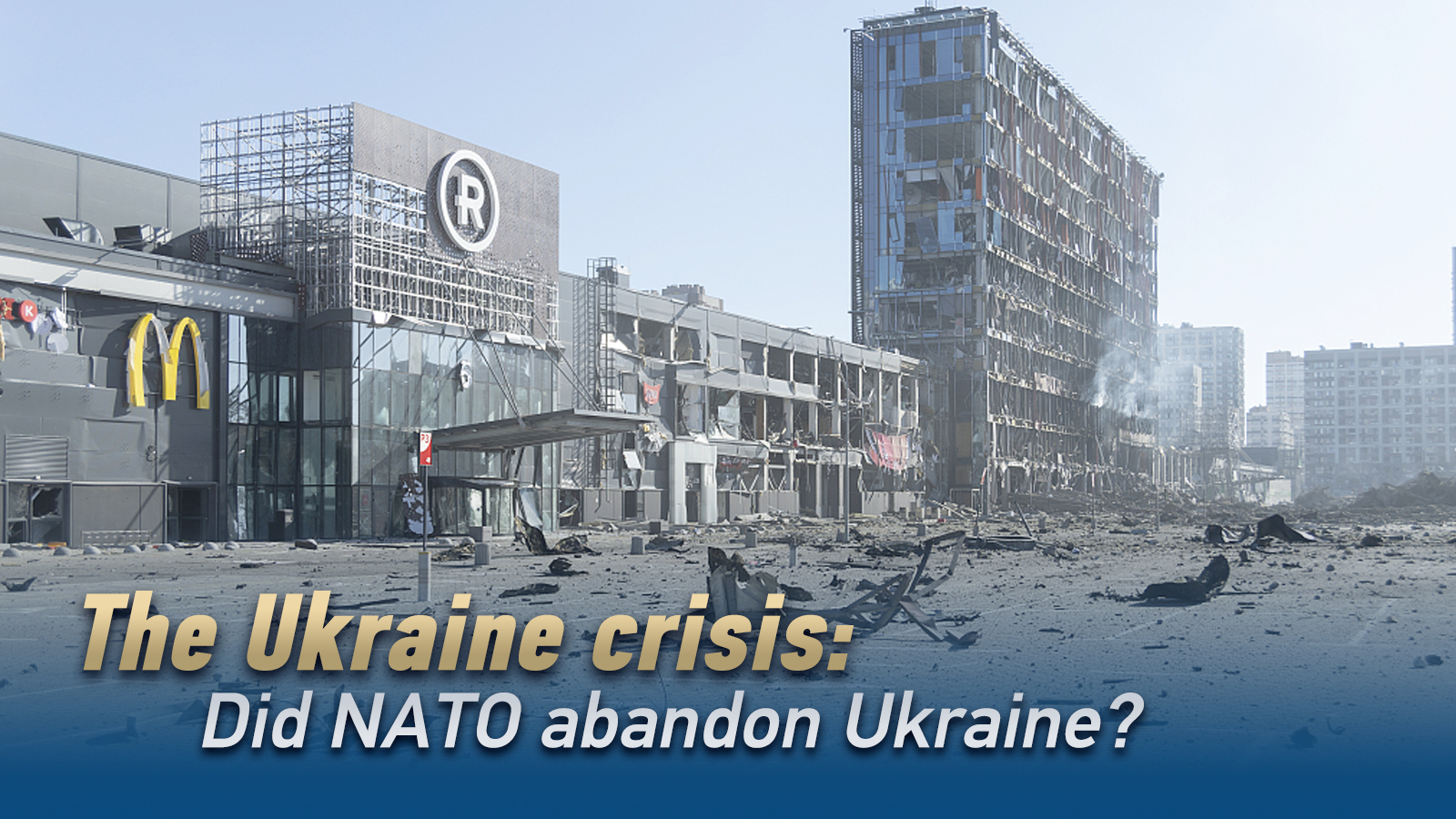
Editor's note: The Ukraine crisis has become the hottest topic in the international community, with lingering destruction inflicted on Ukraine and Russia. What are the driving forces behind the crisis? How will it develop? In the second article of this series, Nikola Mikovic, a freelance journalist based in Serbia, shares his insights. The article reflects the author's opinions and not necessarily those of CGTN.
Ukraine may never join NATO, but the United States-led alliance is expected to continue supplying weapons to the Eastern European nation as long as it takes. Quite aware of a new geopolitical reality, Kyiv no longer insists on a full-fledged NATO membership, but seeks "security guarantees" instead.
According to Ukrainian President Volodymyr Zelenskyy, his country will not be admitted to NATO because its member states "are afraid of Russia." Such a statement could be interpreted as a message to Russia that Ukraine is ready to openly give up its NATO aspirations in order to end the conflict. However, Zelenskyy also insists that any potential deal with Moscow must be decided by a national referendum. Given that polls conducted before Russia launched its special military operation in the former Soviet republic showed that 62 percent of Ukrainian citizens support their country joining NATO, it is not very probable that Zelenskyy would dare to sign an agreement that explicitly states that Ukraine seeks military neutrality.
"Ukraine is expecting and waiting for tangible actions and tangible security guarantees from those whose word is worth confidence and whose deeds can preserve peace," said Zelenskyy in an address to leaders of the NATO countries on March 24.
His statements clearly suggest that he is quite aware that NATO does not see Ukraine as a member-state any time soon, if it all. But that does not necessarily mean that the alliance aims to abandon the Eastern European country. NATO may never fight a direct war against the Russian Federation, but it is not improbable that certain members of the military organization may eventually decide to deploy troops to Ukraine.
After Polish top officials said that NATO-backed "peacekeeping mission" should be sent to Ukraine and be given the means to defend itself, Russia warned that such a move could lead to a direct clash between Russian and NATO forces. Indeed, a deployment of Polish, or any other NATO troops to Ukraine would only add fuel to the fire in the Eastern European country. In that case, Russia and NATO would fight a "proxy World War Three" on Ukrainian territory.
However, if Polish or any other NATO members' troops fight against Russian army in Ukraine, rather than on territory of NATO countries, Warsaw will unlikely be able to demand Brussels to fulfill its obligations under Article 5 of the NATO Charter. In other words, the United States does not have an obligation to intervene if Russia targets NATO troops in Ukraine. That is why Poland will likely think twice before it decides to raise the stakes and intervene in Ukraine.

Ukrainian serviceman of the 30th Army Brigade seen outside Svitlodarsk, Ukraine, January 23, 2022. /VCG
Ukrainian serviceman of the 30th Army Brigade seen outside Svitlodarsk, Ukraine, January 23, 2022. /VCG
Although NATO rules out sending troops to Ukraine, the alliance decided to establish four new battle groups in Slovakia, Romania, Bulgaria, and Hungary, allegedly to prevent the conflict from spilling over to neighboring European countries.
"We have a responsibility to ensure that the war does not escalate beyond Ukraine, and become a conflict between NATO and Russia," said NATO Secretary General Jens Stoltenberg a day prior to the extraordinary summit of NATO Heads of state and government.
Coincidentally or not, NATO summit was held on Mach 24, a day on which the United States and its allies started bombing Serbia in 1999. Back then, the alliance did not launch a ground invasion of the Balkan nation, but used the Albanian guerrilla as a proxy force against the Serbian police and army. In 2022, NATO countries are actively arming Ukraine, although there are no indications that NATO itself will intervene in the Eastern European country.
As the White House press secretary Jen Psaki recently stressed, putting U.S. troops on the ground in Ukraine to fight a war with Russia is not in American national security interests. The upcoming weeks will show if it is in Poland's interests to turn Ukraine into another Syria.
The very fact that Warsaw expelled 45 Russian diplomats, and froze the bank account of the Russian embassy, suggests that some of the European Union members are ready to additionally strain their relations with Moscow. However, the problem for Warsaw is that its contract with Russian energy giant Gazprom expires at the end of year, and the Kremlin said that it would only accept payments in rubles for gas deliveries to "unfriendly countries." Poland is one of them, given that it imposed sanctions on the Russian Federation, but Warsaw, as well as the EU, firmly refuses paying for gas in rubles.
Europe now has a choice: To break its own sanctions against the Russian central bank and purchase Russian rubles, or to stop buying Russian natural gas. Without Russian energy, many European nations risk economic turmoil.
Russia, on the other hand, does not seem to be ready to back down, despite sanctions that the West has imposed on Moscow so far. In the near future, it will be clear if the sanctions have done a greater harm to the Kremlin or to those that have imposed them.
One thing is for sure – Ukraine is currently paying the heaviest price in a new cold war, and will continue paying in the foreseeable future.
(If you want to contribute and have specific expertise, please contact us at opinions@cgtn.com. Follow @thouse_opinions on Twitter to discover the latest commentaries on CGTN Opinion Section.)

